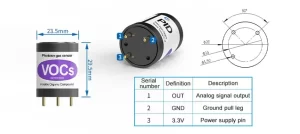-
Gas sensor applications
- Gas sensors are vital components in numerous industries and applications, enabling the detection and measurement of various gases in the environment. These sensors play a crucial role in ensuring safety, monitoring air quality, controllin……
- Chat Online
-
Description
Gas sensors are vital components in numerous industries and applications, enabling the detection and measurement of various gases in the environment. These sensors play a crucial role in ensuring safety, monitoring air quality, controlling industrial processes, and preventing potential hazards. In this article, we will explore the wide range of applications for gas sensors and their significance in different fields.

Environmental Monitoring:
Gas sensors are widely used in environmental monitoring to measure and analyze the concentration of gases in the air. This information is essential for assessing air quality, identifying sources of pollution, and implementing appropriate measures to mitigate environmental risks. Gas sensors can detect gases such as carbon dioxide (CO2), carbon monoxide (CO), sulfur dioxide (SO2), nitrogen dioxide (NO2), and ozone (O3). Environmental monitoring applications include indoor and outdoor air quality monitoring, emissions control, and pollutant source identification.
Industrial Safety:
Gas sensors are critical for ensuring safety in industrial environments where the presence of toxic or combustible gases poses a risk to workers and equipment. These sensors can detect gases such as methane (CH4), hydrogen sulfide (H2S), ammonia (NH3), and volatile organic compounds (VOCs). By continuously monitoring gas levels, gas sensors can trigger alarms or initiate safety protocols to prevent accidents, fires, or explosions. Industrial safety applications include oil and gas refineries, chemical plants, mining operations, and manufacturing facilities.
Fire Detection and Prevention:
Gas sensors are an integral part of fire detection and prevention systems. They can detect gases produced during the early stages of a fire, such as smoke, carbon monoxide, and other combustion by-products. By promptly detecting these gases, gas sensors can trigger alarms, activate sprinkler systems, or notify emergency services, allowing for swift response and minimizing damage. Fire detection and prevention applications include residential, commercial, and industrial buildings, as well as vehicles and aircraft.
Automotive:
Gas sensors are essential components in automotive applications, contributing to vehicle performance, fuel efficiency, and environmental sustainability. These sensors are commonly used in the exhaust systems to monitor and control emissions, ensuring compliance with emission standards. Gas sensors can detect gases such as oxygen (O2), nitrogen oxide (NOx), and hydrocarbons (HC). By providing real-time feedback to the engine management system, gas sensors optimize combustion processes, reduce emissions, and enhance fuel economy.
Healthcare:
Gas sensors have valuable applications in the healthcare industry, particularly in medical devices and monitoring systems. These sensors are used to measure gases such as oxygen, carbon dioxide, and volatile anesthetics. In hospitals, gas sensors are employed in anesthesia machines, ventilators, and respiratory monitoring systems to ensure patient safety and optimize treatment. They are also used in breath analysis for diagnosing certain medical conditions, such as diabetes or lung diseases.
Indoor Air Quality:
Gas sensors are increasingly being used to monitor and improve indoor air quality in residential, commercial, and public buildings. These sensors can detect gases such as CO2, volatile organic compounds (VOCs), and radon. By continuously monitoring indoor air, gas sensors can provide feedback on ventilation efficiency, pollutant levels, and potential health risks. This information allows for the implementation of appropriate ventilation strategies, air filtration systems, and preventive measures to enhance occupant comfort and well-being.
Agriculture:
Gas sensors play a significant role in agricultural applications, helping farmers monitor and optimize crop growth conditions. These sensors can detect gases such as ethylene, ammonia, and carbon dioxide, which are indicators of plant health, ripening, and pest infestation. Gas sensors enable farmers to implement timely interventions, adjust environmental parameters, and maximize crop yield. Additionally, gas sensors are used in controlled atmosphere storage facilities to monitor gas levels and extend the shelf life of fruits and vegetables.

Conclusion:
Gas sensors have diverse applications across various industries, contributing to safety, environmental monitoring, and process control. Whether it's for detecting toxic gases in industrial settings, ensuring air quality in buildings, or optimizing combustion processes in vehicles, gas sensors play a crucial role in maintaining safety, enhancing efficiency, and protecting the environment. With advancements in technology, gas sensors are becoming more accurate, compact, and cost-effective, opening up new possibilities for their utilization in different fields.
-
Recommend:
-
-
Gas detectors are essential devices used to detect and moni…
-
Gas sensors are electronic devices that detect, measure, an…
-
Gas detectors are essential safety tools that detect the pr…
-
Where is the gas detector mainly used
Gas detectors are essential safety tools that detect and mo…
-
 : +86 155 8830 2704
: +86 155 8830 2704 : jxdziot@gmail.com
: jxdziot@gmail.com
